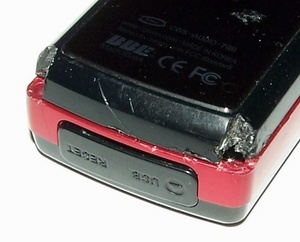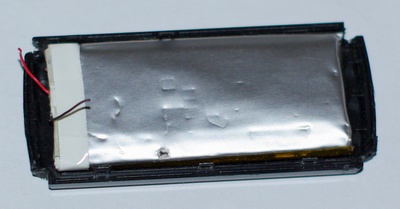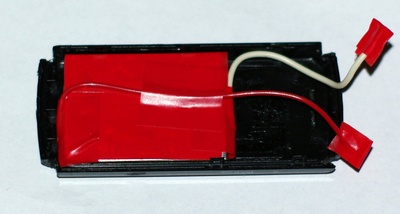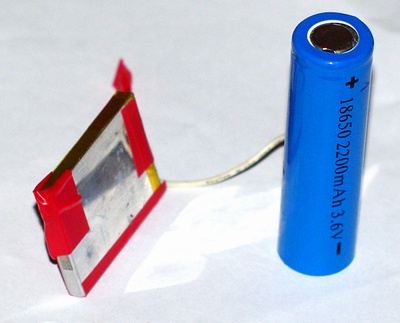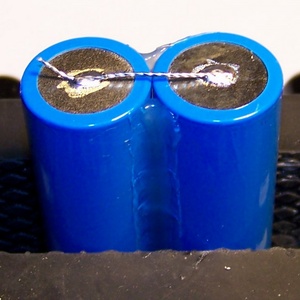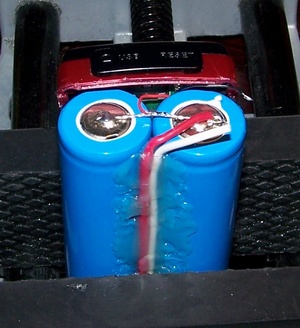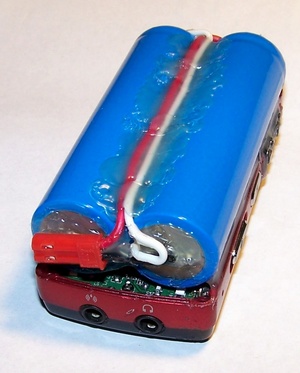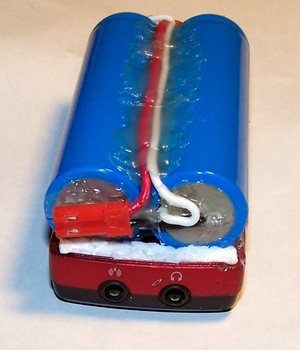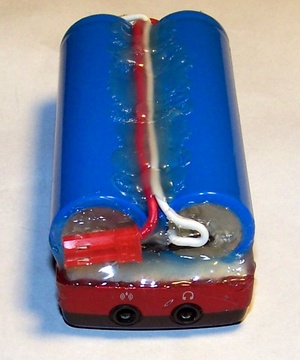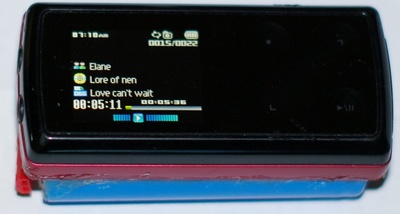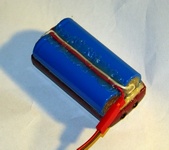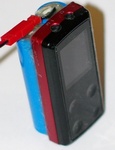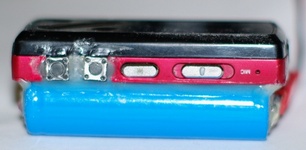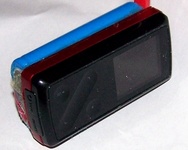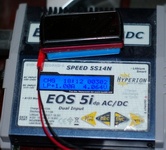Cowon iAudio 7 battery repair/hack
From dead to one week of runtime - continuous!
Category: HackPosted by Fallingwater on 06 August 2011
Original article date: 2nd February 2010
So I bought a 16GB Cowon iAudio 7 music player. It has all one would need: simple yet effective interface, on-the-go playlist creation (a vital point for me), and it can read Ogg Vorbis (which is a great way to shrink the size of your music collection, if you don't mind a small quality loss). How much I paid for it? €16. Because it was broken, you see.
The previous owner had problems with the player constantly switching off on its own; it started as a minor annoyance, but it got progressively worse until the thing became essentially useless. It also had the two volume buttons smashed in.
The biggest problem in fixing the player was opening the darn thing. It was bought refurbished, and whoever did the job closed it with such enthusiasm that they tightened the screws as far as they could possibly go, and then kept at it until they were stripped beyond use.
So how do you crack open a gadget whose screws are stripped so much that screwdrivers basically spin freely, and too small to use specialized screw-extraction gear?
Well...
Yes, brutalizing the case like this (tools used: Dremel with sawblade attachment, hobby knife) did involve a good amount of swearing, and it's a miracle that I didn't bleed at any point during the procedure. But it did allow me to get the thing open, and fix the volume button problem in a most inelegant, but completely functional, way: I cut off the entire part of the case where the volume buttons used to be, and melt-glued tact switches in their place, then soldered their contacts to the pads on the board.
Function over form is one of my fundamental principles, in case it wasn't clear by this point.
With the interface now in working order, all that was left was to figure out the reason of the cutouts. It turned out to be an exceptionally fast diagnosis:
This is something that anyone who knows anything about lithium-based cells is scared stiff of seeing. Lithium polymer cells that get damaged like this can have wildly different reactions, from merely degrading very fast to blowing up in an orgy of flames. The player's previous owner said that the player started out with good battery life, but it degraded very quickly in a matter of months, so it would appear this particular cell took its crippling damage rather gently. I ascribe the hole to the same idiot who must have stripped the screws while "refurbishing" the player.
Metal-cased LiIon cells I don't have problems with, but soft-cased LiPos I don't particularly trust even when intact - let alone when they have holes. Damaged LiPo cells can work more or less fine for a long time (though they usually don't), then blow up on you when you're least expecting it. I quickly disconnected the damaged cell and put it outside in a strong container for safety, while I figure out where in this country I'm supposed to discard it.
For the record, a punctured LiPo cell can be diagnosed with your nose, too, as its innards emanate a rather distinctive sweet smell. That's not an invitation to move in closer and smell stronger - the stuff inside them can be quite toxic. Damaged LiPo cells also often swell up. Notice how this one has the shape of the circuit board imprinted by pressure on its side? It's not supposed to touch the board - it got like that after being punctured.
So anyway, now I had a working player, but without a power source. After rummaging through the battery drawer in my fridge (doesn't everyone have a battery drawer in their fridge?), the only LiIon cell I had that was small enough to fit in the 7's casing was a surplus replacement battery for an iPod Mini. I removed the protection circuitry, hooked it up, and I was able to restore the player to functionality.
That the 7 now worked just fine proved that the old holey LiPo was unquestionably the source of the cut-off problem. However, the cheapo knockoff iPod mini cell has maybe a fifth of the energy of the old LiPo pack (when new and intact), so the 7 now had approximately ten hours of runtime (quoted runtime of a new iAudio 7 is 60 hours, but in the real world 50 is more likely).
I used it like this for a while, and while not unacceptably weak, the small cell required me to worry about recharging more than flash-based players have made me used to (memories of my old 2.5"-hard-disk-based Creative Zen and its 8-hour runtime came flooding back). So I did something about that - proving once again that anything worth doing is worth doing to excess.
The one on the left is the iPod Mini cell (maybe 600mAh of capacity, probably less), which must have been feeling very inadequate in this picture. The blue thing is a 18650 (18mm diameter, 65mm length; the zero at the end means "cylindrical") lithium-ion cell. Your laptop's battery is very likely made of 18650s, as are a number of power packs for other devices. You don't often see the bare cells outside a pre-built battery pack because they're not what you'd call a consumer item - though high-powered 18650-powered flashlights are starting to bring them to the attention of the public at large. 18650s are used so much because they have the best relationship between size, capacity and cost; you can't get more capacity-per-buck in any other size of lithium-based cell.
Brand-name 18650s have up to 2.6 amp-hours of capacity (find them on DealExtreme; trials on the CPF forum have showed that Trustfire-branded ones are the best), but you can get no-branded ones cheaper. They probably won't last as long, and you shouldn't use them in high-drain applications because they're unlikely to have as good a C rating; for low-drain devices, though, they're price-performance winners. The ones I got are rated at 2.2Ah, though I think they're closer to 2Ah (possibly a bit less), and cost me something like $3 each.
The only slight problem in our case is that they're about as long and thick as the player itself, so the idea of keeping the result elegant and super-compact goes right out the window. It won't be a light thing, either, seen how a single 18650 is heavier than the player. So naturally, I used two.
Here they are as I'm putting the pack together. I connected them in parallel (any number of parallel-connected cells behave, electrically, like a single cell with the collective capacity of them all), making them a 4 amp-hour LiIon pack. The build process was easy; tin the terminals, melt-glue together, add wires - done. Then I melt-glued the cells to the back of the player; for now I only put glue along the edges, where the cells touched the plastic casing, just to hold them in place.
Connecting the player was easy. I then put a layer of melt glue on the connections as well to insulate them.
The red square thing is a JST connector (as seen in low-power RC models all over the place). It's there to allow me to charge the big pack with my RC charger; the player retains the ability to charge via USB, but the high-capacity pack would take at least eight hours to get from empty to full on the measly 500mA that's all that USB can provide (and that's without the voltage conversion overheads). The RC charger, in contrast, could charge it in one hour - though I intend to use less drastic settings, as the wires are thin and would drop voltage if I were to run four amps through them.
Now, I wanted the pack to stay in place strongly enough to withstand the occasional fall, but not to be forever mated to the player, because in the future I might need access to its innards to perform further repairs. More glue was needed, but merely splotching it in the rather large empty spaces at the ends of the battery pack would have glued the cells to the circuit board itself, giving me no end of trouble if I were to ever open the player again. So I put thin pieces of styrofoam inbetween the cells and the casing...
...and then liberally spread melt glue on top of them.
With this, the mod was complete. Time for the smoke test:
It works!
If I had any way of machining custom plastic parts I'd make up some sort of enclosure for the back of the player; since I don't, it's staying naked. Metal-cased LiIon cells are pretty tough, so the modified player should resist any damage that doesn't kill me.
During Ogg Vorbis playback, the iAudio 7 draws about 25 milliamps. So in a continuous-playing test, the big pack can be expected to make it last approximately 160 hours, or about six and a half days - more than tripling the original runtime (actual, not quoted). Of course, a normal user is going to be operating the interface for some of that time, and current draw rises when the screen is on (for the record: 40mAh at low brightness, 80mAh at high), but it shouldn't impact runtimes too much.
Oh, and if I'd used 2.6Ah brand-name cells, battery life would have increased to 208 hours, or eight and a half days. That's four times as long as the stock, unmodified player.
Pretty damn nice, if I do say so myself.
Super-long runtimes aren't generally seen as a high priority by player makers. Sure, the dark ages of hard-disk players lasting four hours on a set of four NiMH rechargeables are long gone, but as long as a new player lasts some ten-to-fifteen hours, the problem is considered solved.
While this works for most people, those of us who tend to forget plugging the thing in to charge every other day, or those who like to take a week-long trip without having to carry yet another charger along, do appreciate unusually long runtimes.
There are some players made for such people - I think the one with the longest runtime is actually the stock iAudio 7. And, to be completely truthful, if I had been given one with a working, good-condition LiPo cell, I'd have probably been content with the stock fifty hours of runtime.
But if you want more runtime and don't mind some added heft to your player, you can do an easy mod like this to increase its battery life beyond anything that's ever been sold in stores.
By the way, this modding technique is compatible with any player that uses LiIon cells and that you don't mind taking apart and hooking inelegant external packs to. Anything, from iPods to chinese knockoffs, can be hooked to larger LiIon cells, and the gadget won't mind. The only limit to runtimes is how big and heavy a player you're comfortable with; of course, starting with an energy-efficient player like an iAudio 7 (over, say, anything with a hard drive in it) gives you a significant head start.
I'm not sure what sort of trouble you'd go through if you tried to sneak one onboard a plane, though...
Lastly, a few more glamour shots, including one of the RC charger doing its job:
So I bought a 16GB Cowon iAudio 7 music player. It has all one would need: simple yet effective interface, on-the-go playlist creation (a vital point for me), and it can read Ogg Vorbis (which is a great way to shrink the size of your music collection, if you don't mind a small quality loss). How much I paid for it? €16. Because it was broken, you see.
The previous owner had problems with the player constantly switching off on its own; it started as a minor annoyance, but it got progressively worse until the thing became essentially useless. It also had the two volume buttons smashed in.
The biggest problem in fixing the player was opening the darn thing. It was bought refurbished, and whoever did the job closed it with such enthusiasm that they tightened the screws as far as they could possibly go, and then kept at it until they were stripped beyond use.
So how do you crack open a gadget whose screws are stripped so much that screwdrivers basically spin freely, and too small to use specialized screw-extraction gear?
Well...
Yes, brutalizing the case like this (tools used: Dremel with sawblade attachment, hobby knife) did involve a good amount of swearing, and it's a miracle that I didn't bleed at any point during the procedure. But it did allow me to get the thing open, and fix the volume button problem in a most inelegant, but completely functional, way: I cut off the entire part of the case where the volume buttons used to be, and melt-glued tact switches in their place, then soldered their contacts to the pads on the board.
Function over form is one of my fundamental principles, in case it wasn't clear by this point.
With the interface now in working order, all that was left was to figure out the reason of the cutouts. It turned out to be an exceptionally fast diagnosis:
This is something that anyone who knows anything about lithium-based cells is scared stiff of seeing. Lithium polymer cells that get damaged like this can have wildly different reactions, from merely degrading very fast to blowing up in an orgy of flames. The player's previous owner said that the player started out with good battery life, but it degraded very quickly in a matter of months, so it would appear this particular cell took its crippling damage rather gently. I ascribe the hole to the same idiot who must have stripped the screws while "refurbishing" the player.
Metal-cased LiIon cells I don't have problems with, but soft-cased LiPos I don't particularly trust even when intact - let alone when they have holes. Damaged LiPo cells can work more or less fine for a long time (though they usually don't), then blow up on you when you're least expecting it. I quickly disconnected the damaged cell and put it outside in a strong container for safety, while I figure out where in this country I'm supposed to discard it.
For the record, a punctured LiPo cell can be diagnosed with your nose, too, as its innards emanate a rather distinctive sweet smell. That's not an invitation to move in closer and smell stronger - the stuff inside them can be quite toxic. Damaged LiPo cells also often swell up. Notice how this one has the shape of the circuit board imprinted by pressure on its side? It's not supposed to touch the board - it got like that after being punctured.
So anyway, now I had a working player, but without a power source. After rummaging through the battery drawer in my fridge (doesn't everyone have a battery drawer in their fridge?), the only LiIon cell I had that was small enough to fit in the 7's casing was a surplus replacement battery for an iPod Mini. I removed the protection circuitry, hooked it up, and I was able to restore the player to functionality.
That the 7 now worked just fine proved that the old holey LiPo was unquestionably the source of the cut-off problem. However, the cheapo knockoff iPod mini cell has maybe a fifth of the energy of the old LiPo pack (when new and intact), so the 7 now had approximately ten hours of runtime (quoted runtime of a new iAudio 7 is 60 hours, but in the real world 50 is more likely).
I used it like this for a while, and while not unacceptably weak, the small cell required me to worry about recharging more than flash-based players have made me used to (memories of my old 2.5"-hard-disk-based Creative Zen and its 8-hour runtime came flooding back). So I did something about that - proving once again that anything worth doing is worth doing to excess.
The one on the left is the iPod Mini cell (maybe 600mAh of capacity, probably less), which must have been feeling very inadequate in this picture. The blue thing is a 18650 (18mm diameter, 65mm length; the zero at the end means "cylindrical") lithium-ion cell. Your laptop's battery is very likely made of 18650s, as are a number of power packs for other devices. You don't often see the bare cells outside a pre-built battery pack because they're not what you'd call a consumer item - though high-powered 18650-powered flashlights are starting to bring them to the attention of the public at large. 18650s are used so much because they have the best relationship between size, capacity and cost; you can't get more capacity-per-buck in any other size of lithium-based cell.
Brand-name 18650s have up to 2.6 amp-hours of capacity (find them on DealExtreme; trials on the CPF forum have showed that Trustfire-branded ones are the best), but you can get no-branded ones cheaper. They probably won't last as long, and you shouldn't use them in high-drain applications because they're unlikely to have as good a C rating; for low-drain devices, though, they're price-performance winners. The ones I got are rated at 2.2Ah, though I think they're closer to 2Ah (possibly a bit less), and cost me something like $3 each.
The only slight problem in our case is that they're about as long and thick as the player itself, so the idea of keeping the result elegant and super-compact goes right out the window. It won't be a light thing, either, seen how a single 18650 is heavier than the player. So naturally, I used two.
Here they are as I'm putting the pack together. I connected them in parallel (any number of parallel-connected cells behave, electrically, like a single cell with the collective capacity of them all), making them a 4 amp-hour LiIon pack. The build process was easy; tin the terminals, melt-glue together, add wires - done. Then I melt-glued the cells to the back of the player; for now I only put glue along the edges, where the cells touched the plastic casing, just to hold them in place.
Connecting the player was easy. I then put a layer of melt glue on the connections as well to insulate them.
The red square thing is a JST connector (as seen in low-power RC models all over the place). It's there to allow me to charge the big pack with my RC charger; the player retains the ability to charge via USB, but the high-capacity pack would take at least eight hours to get from empty to full on the measly 500mA that's all that USB can provide (and that's without the voltage conversion overheads). The RC charger, in contrast, could charge it in one hour - though I intend to use less drastic settings, as the wires are thin and would drop voltage if I were to run four amps through them.
Now, I wanted the pack to stay in place strongly enough to withstand the occasional fall, but not to be forever mated to the player, because in the future I might need access to its innards to perform further repairs. More glue was needed, but merely splotching it in the rather large empty spaces at the ends of the battery pack would have glued the cells to the circuit board itself, giving me no end of trouble if I were to ever open the player again. So I put thin pieces of styrofoam inbetween the cells and the casing...
...and then liberally spread melt glue on top of them.
With this, the mod was complete. Time for the smoke test:
It works!
If I had any way of machining custom plastic parts I'd make up some sort of enclosure for the back of the player; since I don't, it's staying naked. Metal-cased LiIon cells are pretty tough, so the modified player should resist any damage that doesn't kill me.
Runtimes and conclusions
During Ogg Vorbis playback, the iAudio 7 draws about 25 milliamps. So in a continuous-playing test, the big pack can be expected to make it last approximately 160 hours, or about six and a half days - more than tripling the original runtime (actual, not quoted). Of course, a normal user is going to be operating the interface for some of that time, and current draw rises when the screen is on (for the record: 40mAh at low brightness, 80mAh at high), but it shouldn't impact runtimes too much.
Oh, and if I'd used 2.6Ah brand-name cells, battery life would have increased to 208 hours, or eight and a half days. That's four times as long as the stock, unmodified player.
Pretty damn nice, if I do say so myself.
Super-long runtimes aren't generally seen as a high priority by player makers. Sure, the dark ages of hard-disk players lasting four hours on a set of four NiMH rechargeables are long gone, but as long as a new player lasts some ten-to-fifteen hours, the problem is considered solved.
While this works for most people, those of us who tend to forget plugging the thing in to charge every other day, or those who like to take a week-long trip without having to carry yet another charger along, do appreciate unusually long runtimes.
There are some players made for such people - I think the one with the longest runtime is actually the stock iAudio 7. And, to be completely truthful, if I had been given one with a working, good-condition LiPo cell, I'd have probably been content with the stock fifty hours of runtime.
But if you want more runtime and don't mind some added heft to your player, you can do an easy mod like this to increase its battery life beyond anything that's ever been sold in stores.
By the way, this modding technique is compatible with any player that uses LiIon cells and that you don't mind taking apart and hooking inelegant external packs to. Anything, from iPods to chinese knockoffs, can be hooked to larger LiIon cells, and the gadget won't mind. The only limit to runtimes is how big and heavy a player you're comfortable with; of course, starting with an energy-efficient player like an iAudio 7 (over, say, anything with a hard drive in it) gives you a significant head start.
I'm not sure what sort of trouble you'd go through if you tried to sneak one onboard a plane, though...
Lastly, a few more glamour shots, including one of the RC charger doing its job:
lppan2 wrote on December 27, 2016:
I know this is a very old post, but if fallingwater or anyone else comes along that would know the dimensions of the PR-552963 it would be helpful. My iAudio 7 still works but the run time is down to a few hours. As a result I really do not want to try disassembling it now but it would be nice to have a battery on hand for when I do take it apart after the battery deteriorates further. I can make a good guess at the length and width but not so the thickness. PR-552963 batteries do not seem to be available but if I could find a battery of similar size or slightly smaller it should give me the same or a slightly less mAH rating. The thickness seems to be very important to the mAH rating so the exact thickness of the PR-552963 would give me the best chance of finding a high mAH battery that would still fit.
Jodli wrote on April 13, 2013:
Just stumbled over that blog by searching something completely different.
Had to read it!
And also had to comment it :)
Pretty cool.
I will definitely read more here.
btw:
Registering an account on this site is pretty hard, since the "password-length"-check is a bit buggy. my password from https://www.pwdhash.com/ is to short (when I copy an paste it). Typing the password with my pwdhash-extention is out of question too :)
Had to read it!
And also had to comment it :)
Pretty cool.
I will definitely read more here.
btw:
Registering an account on this site is pretty hard, since the "password-length"-check is a bit buggy. my password from https://www.pwdhash.com/ is to short (when I copy an paste it). Typing the password with my pwdhash-extention is out of question too :)
 Cowon iAudio 7 battery repair/hack
Cowon iAudio 7 battery repair/hack 